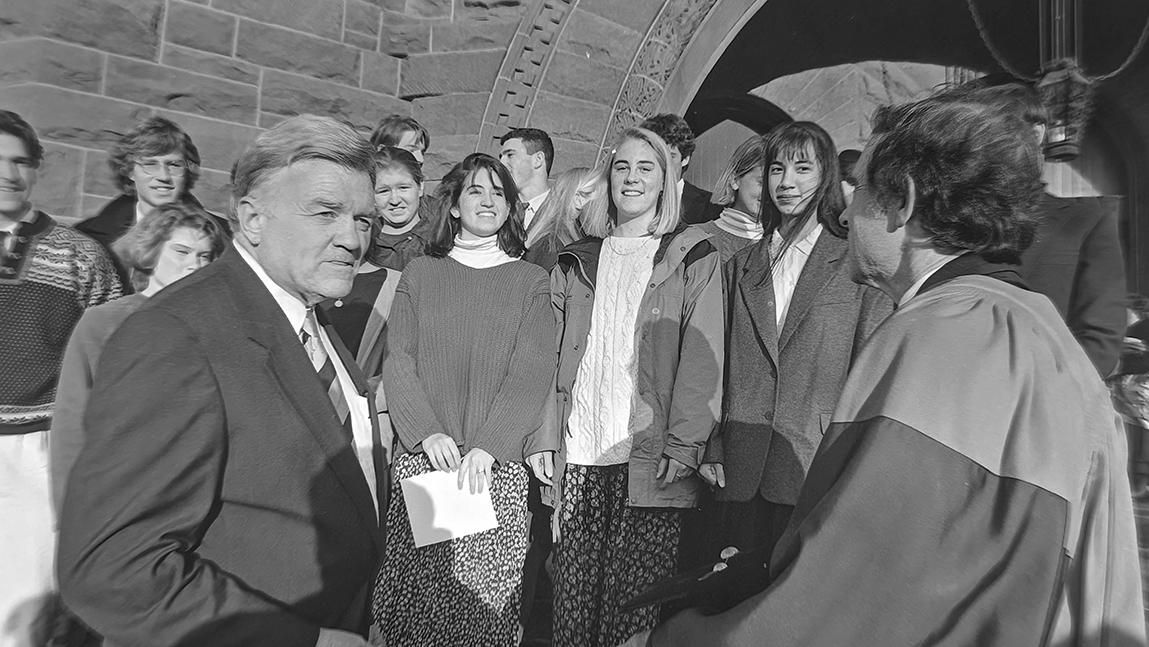Vermont
Vermont schools sue Monsanto over toxic PCB contamination

Dozens of Vermont school districts have sued chemical giant Monsanto over toxic contamination in educational buildings from now-banned industrial chemicals known as PCBs.
Last year, Vermont became the first state in the country to require older schools get tested for polychlorinated biphenyls, which were used in building materials and electrical equipment before 1980.
More than 90 school districts filed the complaint on Friday in federal court. They’re seeking to recover costs and damages because, under Vermont’s law, schools with high-enough contamination levels must reduce exposure. Removing the PCBs will be expensive, and certain districts may have to demolish buildings and replace them with new ones — which in total could cost them “hundreds of millions, if not billions, of dollars,” the lawsuit says.
The PCBs are present in the school buildings from caulking and glazing compounds, sealants, adhesives, and other construction materials.
Monsanto said the case has no merit and that “third party companies, not Monsanto” produced the PCB-laden materials used at the schools.
“Monsanto never manufactured, used or disposed of PCBs in Vermont and has not manufactured these products for more than 45 years,” the company said in a statement late Monday. Monsanto is now owned by Bayer, the pharmaceutical and biotechnology company.
The company is also seeking an emergency hearing and the preservation of evidence. Monsanto wants the districts to let it participate in environmental testing and PCB-source identification, and to document and observe the remediation work.
PCBs were used in building materials and electrical equipment like transformers, capacitors and fluorescent lighting ballasts. The U.S. Environmental Protection Agency banned manufacturing and certain uses of them in 1979 over concerns they could cause cancer and other illnesses, according to the Vermont Department of Environmental Conservation.
A 2019 Associated Press investigation found that millions of fluorescent light ballasts containing PCBs probably remain in schools and day care centers across the U.S. — four decades after the chemicals were banned.
The chemicals can be released into the air and students and staff can be exposed by breathing in dust or vapors containing them; getting dust on their hands and then consuming it while eating or drinking; and having skin contact with materials that contain the chemicals, according to the department.
PCB contamination forced an entire Vermont high school to move into a closed department store in downtown Burlington, where students have taken classes since March 2021 while the old school is being demolished. The store connected to a now-closed mall underwent a $3.5 million retrofit supported by the state.
Two years ago, three teachers in Washington state who sued Monsanto over exposure to PCBs in fluorescent lights were awarded $185 million. The teachers, who worked at the Sky Valley Education Center in Monroe, Washington, said they suffered brain damage from exposure to PCBs in the fluorescent lighting at the school.
The Vermont attorney general also sued Monsanto last month over PCB contamination in Vermont’s schools and natural resources. The chemicals are highly persistent and continue to circulate in Vermont’s waters and other natural resources, and have accumulated to dangerous levels in sediment, wildlife and fish, according to the lawsuit. Vermont has a fish consumption advisory for all of Lake Champlain and the Hoosic River because of the contamination, the lawsuit states.
Monsanto also said that lawsuit had no merit for the same reasons it cited in the school districts’ case.
_____
Rathke reported from Marshfield, Vt.

Vermont
Former UVM President Thomas P. Salmon Dies at 92

Born in Cleveland, Ohio, in1932, Salmon was raised in…
Vermont
‘The Sex Lives of College Girls’ is set at a fictional Vermont college. Where is it filmed?

The most anticipated TV shows of 2025
USA TODAY TV critic Kelly Lawler shares her top 5 TV shows she is most excited for this year
It’s time to hit the books: one of Vermont’s most popular colleges may be one that doesn’t exist.
The Jan. 15 New York Times mini crossword game hinted at a fictional Vermont college that’s used as the setting of the show “The Sex Lives of College Girls.”
The show, which was co-created by New Englander Mindy Kaling, follows a group of women in college as they navigate relationships, school and adulthood.
“The Sex Lives of College Girls” first premiered on Max, formerly HBO Max, in 2021. Its third season was released in November 2024.
Here’s what to know about the show’s fictional setting.
What is the fictional college in ‘The Sex Lives of College Girls’?
“The Sex Lives of College Girls” takes place at a fictional prestigious college in Vermont called Essex College.
According to Vulture, Essex College was developed by the show’s co-creators, Kaling and Justin Noble, based on real colleges like their respective alma maters, Dartmouth College and Yale University.
“Right before COVID hit, we planned a research trip to the East Coast and set meetings with all these different groups of young women at these colleges and chatted about what their experiences were,” Noble told the outlet in 2021.
Kaling also said in an interview with Parade that she and Noble ventured to their alma maters because they “both, in some ways, fit this East Coast story” that is depicted in the show.
Where is ‘The Sex Lives of College Girls’ filmed?
Although “The Sex Lives of College Girls” features a New England college, the show wasn’t filmed in the area.
The show’s first season was filmed in Los Angeles, while some of the campus scenes were shot at Vassar College in Poughkeepsie, New York. The second season was partially filmed at the University of Washington in Seattle, Washington.
Vermont
Tom Salmon, governor behind ‘the biggest political upset in Vermont history,’ dies at 92 – VTDigger

When Vermont Democrats lacked a gubernatorial candidate the afternoon of the primary deadline in August 1972, Rockingham lawyer Tom Salmon, in the most last-minute of Hail Mary passes, threw his hat in the ring.
“There could be a whale of a big surprise,” Salmon was quoted as saying by skeptical reporters who knew the former local legislator had been soundly beached in his first try for state office two years earlier.
Then a Moby Dick of a shock came on Election Day, spurring the Burlington Free Press to deem Salmon’s Nov. 7, 1972, victory over the now late Republican businessman Luther “Fred” Hackett “the biggest political upset in Vermont history.”
Salmon, who served two terms as governor, continued to defy the odds in subsequent decades, be it by overcoming a losing 1976 U.S. Senate bid to become president of the University of Vermont, or by entering a Brattleboro convalescent home in 2022, only to confound doctors by living nearly three more years until his death Tuesday.
Salmon, surrounded by family, died just before sundown at the Pine Heights Center for Nursing and Rehabilitation at age 92, his children announced shortly after.
“Your man Winston Churchill always said, ‘Never, never, never, never give up,” Salmon’s son, former state Auditor Thomas M. Salmon, recalled telling his father in his last days, “and Dad, you’ve demonstrated that.”
Born in the Midwest and raised in Massachusetts, Thomas P. Salmon graduated from Boston College Law School before moving to Rockingham in 1958 to work as an attorney, a municipal judge from 1963 to 1965, and a state representative from 1965 to 1971.
Salmon capped his legislative tenure as House minority leader. But his political career hit a wall in 1970 when he lost a race for attorney general by 17 points to incumbent Jim Jeffords, the now late maverick Republican who’d go on to serve in the U.S. House and Senate before his seismic 2001 party switch.

Vermont had made national news in 1962 when the now late Philip Hoff became the first Democrat to win popular election as governor since the founding of the Republican Party in 1854. But the GOP had a vise-grip on the rest of the ballot, held two-thirds of all seats in the Legislature and took back the executive chamber when the now deceased insurance executive Deane Davis won after Hoff stepped down in 1968.
As Republican President Richard Nixon campaigned for reelection in 1972, Democrats were split over whether to support former Vice President Hubert Humphrey or U.S. senators George McGovern or Edmund Muskie. The Vermont party was so divided, it couldn’t field a full slate of aspirants to run for state office.
“The reason that we can’t get candidates this year is that people don’t want to get caught in the struggle,” Hoff told reporters at the time. “The right kind of Democrat could have a good chance for the governorship this year, but we have yet to see him.”
Enter Salmon. Two years after his trouncing, he had every reason not to run again. Then he attended the Miami presidential convention that nominated McGovern.
“I listened to the leadership of the Democratic Party committed to tilting at windmills against what seemed to be the almost certain reelection of President Nixon,” Salmon recalled in a 1989 PBS interview with journalist Chris Graff. “That very night I made up my mind I was going to make the effort despite the odds.”

Before Vermont moved its primaries to August in 2010, party voting took place in September. That’s why Salmon could wait until hours before the Aug. 2, 1972, filing deadline to place his name on the ballot.
“Most Democratic leaders conceded that Salmon’s chances of nailing down the state’s top job are quite dim,” wrote the Rutland Herald and Times Argus, reporting that Salmon was favored by no more than 18% of those surveyed.
(Gov. Davis’ preferred successor, Hackett, was the front-runner. A then-unknown Liberty Union Party candidate — Bernie Sanders — rounded out the race.)
“We agreed that there was no chance of our winning the election unless the campaign stood for something,” Salmon said in his 1989 PBS interview. “Namely, addressed real issues that people in Vermont cared about.”
Salmon proposed to support average residents by reforming the property tax and restricting unplanned development, offering the motto “Vermont is not for sale.” In contrast, his Republican opponent called for repealing the state’s then-new litter-decreasing bottle-deposit law, while a Rutland County representative to the GOP’s National Committee, Roland Seward, told reporters, “What are we saving the environment for, the animals?”
As Republicans crowded into a Montpelier ballroom on election night, Salmon stayed home in the Rockingham village of Bellows Falls — the better to watch his then 9-year-old namesake son join a dozen friends in breaking a garage window during an impromptu football game, the press would report.
At 10:20 p.m., CBS news anchor Walter Cronkite interrupted news of a Nixon landslide to announce, “It looks like there’s an upset in the making in Vermont.”
The Rutland Herald and Times Argus summed up Salmon’s “winning combination” (he scored 56% of the vote) as “the image of an underdog fighting ‘the machine’” and “an appeal to the pocketbook on taxes and electric power.”
Outgoing Gov. Davis would later write in his autobiography that the Democrat was “an extremely intelligent, articulate, handsome individual with loads of charm.”
“Salmon accepted a challenge which several other Democrats had turned down,” the Free Press added in an unusual front-page editorial of congratulations. “He then accomplished what almost all observers saw as a virtual impossibility.”

As governor, Salmon pushed for the prohibition of phosphates in state waters and the formation of the Agency of Transportation. Stepping down after four years to run for U.S. Senate in 1976, he was defeated by incumbent Republican Robert Stafford, the now late namesake of the Stafford federal guaranteed student loan program.
Salmon went on to serve as president of the University of Vermont and chair of the board of Green Mountain Power. In his 1977 gubernatorial farewell address, he summed up his challenges — and said he had no regrets.
“A friend asked me the other day if it was all worth it,” Salmon said. “Wasn’t I owed more than I received with the energy crisis, Watergate, inflation, recession, natural disasters, no money, no snow, a tax revolt, and the anxiety of our people over government’s capacity to respond to their needs? My answer was this: I came to this state in 1958 with barely enough money in my pocket to pay for an overnight room. In 14 short years I became governor. The people of Vermont owe me nothing. I owe them everything for the privilege of serving two terms in the highest office Vermont can confer on one of its citizens.”
-
/cdn.vox-cdn.com/uploads/chorus_asset/file/25822586/STK169_ZUCKERBERG_MAGA_STKS491_CVIRGINIA_A.jpg)
/cdn.vox-cdn.com/uploads/chorus_asset/file/25822586/STK169_ZUCKERBERG_MAGA_STKS491_CVIRGINIA_A.jpg) Technology6 days ago
Technology6 days agoMeta is highlighting a splintering global approach to online speech
-

 Science4 days ago
Science4 days agoMetro will offer free rides in L.A. through Sunday due to fires
-
/cdn.vox-cdn.com/uploads/chorus_asset/file/25821992/videoframe_720397.png)
/cdn.vox-cdn.com/uploads/chorus_asset/file/25821992/videoframe_720397.png) Technology1 week ago
Technology1 week agoLas Vegas police release ChatGPT logs from the suspect in the Cybertruck explosion
-

 Movie Reviews1 week ago
Movie Reviews1 week ago‘How to Make Millions Before Grandma Dies’ Review: Thai Oscar Entry Is a Disarmingly Sentimental Tear-Jerker
-

 Health1 week ago
Health1 week agoMichael J. Fox honored with Presidential Medal of Freedom for Parkinson’s research efforts
-

 Movie Reviews1 week ago
Movie Reviews1 week agoMovie Review: Millennials try to buy-in or opt-out of the “American Meltdown”
-

 News1 week ago
News1 week agoPhotos: Pacific Palisades Wildfire Engulfs Homes in an L.A. Neighborhood
-

 World1 week ago
World1 week agoTrial Starts for Nicolas Sarkozy in Libya Election Case
















